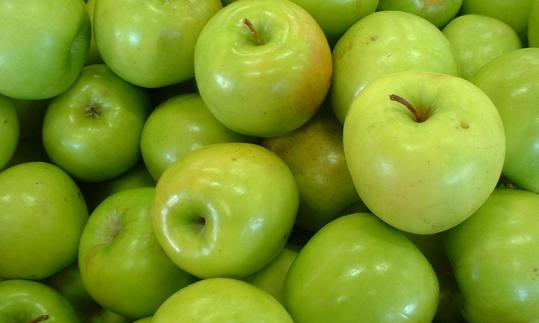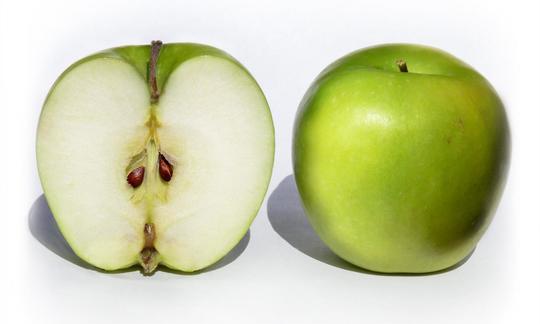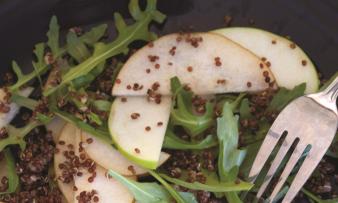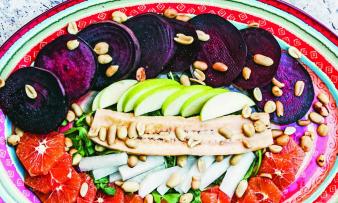Table of contents
The 'Granny Smith' apple variety, discovered by chance in Australia, is one of the sourest commercially available apples ( Malus domestica ) due to its high fruit acid content. In addition to the sour, refreshing taste, the good storage capacity has also contributed to the popularity of 'Granny Smith' apples on the export market. Make sure they are organic!
Use in the kitchen:
The light green, slightly speckled 'Granny Smith' apples are very popular as a raw snack between meals. Biting through the thin, bright green skin reveals the white, firm and, above all, juicy flesh. The taste is intensely sour; some say the apple has notes of green herbs, lime, mint, medlar, matcha and gooseberries. 1 Those who prefer sweeter varieties (such as'Gala' ) find 'Granny Smith' to be merely sour.
'Granny Smith' apples are also suitable for baking with the skin on , as they retain their firm consistency, and for slightly sour apple rings . In addition to apple pie or apple cobbler (crumble), they can also be used to make apple turnovers. Apple sauce or compote made from this apple variety is usually peeled and slightly sweetened. The crisp, fresh 'Granny Smith' apples are also popular diced in muesli or as a sweet and sour, refreshing component in salads.
Due to the high fruit acid content, the 'Granny Smith' is less suitable for making apple juice. The effect that most consumers find positive is that this variety does not quickly turn brown after peeling or cutting.
Vegan recipe for smoothie with 'Granny Smith' apples:
Ingredients: 1 piece (approx. 40 g) fresh ginger , 4 kiwis , 150 g cucumber , 2 'Granny Smith' apples, 4-6 mint leaves , 250 ml clear apple juice , crushed ice.
Preparation: Peel the ginger and grate finely. Peel the kiwis and cut into pieces. Wash, peel and chop the cucumber. Wash, peel, quarter, core and chop the apples. Wash and dry the mint. Put all the ingredients in a blender and mix with the apple juice to make a smoothie. Divide between four glasses and serve with crushed ice.
Vegan recipe for apple crumble with 'Granny Smith':
Ingredients: 600 g 'Granny Smith' apples (or other sour varieties such as 'Boskoop' or 'Elstar'), 2 tbsp sugar , 1 tsp ground cinnamon . For the crumble: 120 g vegan margarine , 120 g oat flakes , 150 g wheat flour , 2 tbsp raw sugar .
Preparation: Preheat the oven to 190 °C top and bottom heat. Wash the apples, quarter them, remove the cores and cut them into pieces. Mix the apple pieces with the sugar and cinnamon and place them in a medium-sized or 4 small, fireproof molds. Press the fruit firmly into the mold so that it does not mix too much with the crumbles. For the crumbles, mix the flour, oat flakes and sugar and fold the margarine, cut into small pieces, into the mixture with your fingers. Rub the dry ingredients well into the margarine. Spread the crumbles evenly into the mold(s) and bake in the oven for 35-40 minutes. Allow the apple crumble to cool for about 10 minutes before serving.
Vegan recipes with Granny Smith can be found under the note: " Recipes that have the most of this ingredient ".
| Not only vegans or vegetarians should read this: Vegans often eat unhealthily. Avoidable nutritional mistakes . |
Shopping - where to buy?
The 'Granny Smith' apple variety can be found in every supermarket such as Coop , Migros , Denner , Volg , Spar , Aldi , Lidl , Rewe , Edeka , Hofer etc., usually from October to June. European apples are only ripe enough to eat in January. 2 With this variety, you should definitely pay attention to the origin. Since these fruits need a very warm climate to ripen, the 'Granny Smith' usually comes from southern countries.
'Granny Smith' can usually be found in organic supermarkets ( Denn's Biomarkt , Alnatura ) and organic shops, and occasionally in health food stores and at weekly markets. Due to the high susceptibility of commercial varieties to disease and the frequent plant protection measures that this entails, it is important to give preference to organically produced apples (see also "Ecological aspects" below).
Storage:
Storage under a controlled atmosphere is common in the trade (CA storage or DCA storage). This allows the concentrations of oxygen, carbon dioxide and nitrogen to be adjusted depending on the method. With ULO storage (ultra low oxygen), the O 2 content is reduced to a very low value (1.3-1.5 vol. %), which is intended to preserve the quality for even longer. 3 'Granny Smith' can last up to a year under optimal storage conditions without any major loss of quality. The good storage stability is also attributed to lower ethylene production. 4
A typical storage disease that occurs particularly in early harvested varieties (such as 'Granny Smith' or 'Red Delicious') is common browning of the skin. This browning of the skin occurs mainly during shelf life; the skin sinks slightly, but the flesh is usually not affected. High temperatures shortly before harvest and the cold shock (chilling) immediately afterwards significantly promote this effect. Diffuse browning of the skin is also a storage disease in the 'Granny Smith' variety. This causes superficial browning that shows through the fruit skin and can feel rough. Post-harvest treatments with the ripening inhibitor 1-methylcyclopropene (1-MCP) intensify this damage. 5 This ripening inhibitor is not permitted in organic farming . 6
Ingredients - nutritional value - calories:
Like all apples, this type of apple has a low energy content of around 58 kcal/100g, which comes mainly from carbohydrates (14%). The sugar content can vary slightly, but is similar to that of the significantly sweeter tasting 'Gala'. This can also be seen in the sugar measurement in degrees Brix (one degree Brix-Fischer is 1 g sucrose in 100 g solution), which was around 10.5-11.7 for the 'Granny Smith', 10.3-11.0 for the 'Gala' and 12.4-13.1 for the 'Golden Delicious' (these values are from 2005 and 2006). 7
The potassium content is around 120 mg per 100 g, which is about the same as in the Nashi pear or the vegetable onion . Sun-dried tomatoes have far more potassium at 3,425 mg/100g and cover more than 100% of the daily requirement, and dried wild garlic also has around 2,549 mg per 100 g. Potassium is an essential element, so we must get it from food. A balanced, natural diet usually covers the requirement well. Potassium is important for maintaining osmotic pressure, regulating blood pressure and acid-base balance. 8
Vitamin K is present at 3.2 µg/100g, which is similar to that found in butternut squash or apricots . The fat-soluble vitamin is mainly found in green leafy vegetables, for example chard contains 830 µg/100g, kale 705 µg/100g or garden cress 542 µg/100g, which is many times more than the daily requirement per 100g. Since this vitamin is sensitive to light, these foods should be stored in the dark. Vitamin K is important for blood clotting and plays an essential role in bone metabolism. 8
B vitamins such as vitamin B 6 (pyridoxine) , vitamin B 1 (thiamine) and vitamin B 2 (riboflavin) are also contained in small amounts in 'Granny Smith'.
If you eat the apples with the peel, the secondary plant substances (phytochemicals) they contain, such as phenols and flavonoids, also make a significant contribution to health. 9 Here you can find a summary of the article Antioxidant activity of fresh apples .
The complete ingredients of Granny Smith apples , the coverage of the daily requirement and comparison values with other ingredients can be found in our nutrient tables. In the article Nutrients explained you will get a detailed insight into the topic. CLICK FOR before the text.
Health aspects - effects:
Among the many commercial varieties, the 'Granny Smith' has a significantly higher content of fiber and poorly digestible carbohydrates, which promotes digestion and is said to restore a disturbed microbiota balance in the intestine in cases of obesity. 10
A green apple has per se fewer anthocyanins than a red apple, because this pigment is mainly found in red apples. However, green apples contain more chlorophyll and yellow carotene. No matter what color: In and directly under the peel there are many secondary plant substances that have an anti-inflammatory and blood sugar-lowering effect. Above all, a slightly bitter taste indicates an increased polyphenol content, which is mainly noticeable in the taste of old varieties such as 'Cox Orange', 'Boskoop' or 'Berlepsch'. 11
Red apples of old varieties in particular have more secondary plant substances, as well as more vitamin C and other healthy vitamins and minerals. Apples with a high content of secondary plant substances brown more quickly. 12 The trade takes advantage of this effect with the 'Granny Smith' - but this also means that in this case it should have fewer secondary plant substances than old varieties. 13 According to a study from 2013, the Granny Smith contains fewer phenolic compounds than the varieties 'Gala', 'Fuji' and 'Golden Delicious' (ascending). 22 However, some of these nutritional studies and their interpretations should be treated with caution as they are not simply comparable: They rarely refer to the same apple varieties, the same phenolic compounds or the same health effects.
Dangers - Intolerances - Side effects:
Apples with fewer polyphenols contain more apple allergens. People who are allergic to apples react more strongly to commercial varieties in particular. This allergy is often accompanied by a pollen allergy to hazel, alder or birch. This is caused by allergens that are similar to the allergens in birch pollen (so-called "cross-reactivity"). If you eat low-allergen apples over a longer period of time, i.e. old varieties such as 'Alkmene', 'Eifeler Rambur', 'Goldparmäne', 'Gravensteiner', 'Jonathan' and 'Boskoop', allergy sufferers will tolerate the commercial varieties better. 14
Since birch pollen has similar allergens to apples, intolerance reactions are common, particularly with commercial varieties such as 'Granny Smith', 'Braeburn', 'Cox Orangen-Renette', 'Elstar', 'Gala', 'Golden Delicious', 'Red Delicious', 'Fuji', 'Jonagold' and 'Ingrid Marie'. 15
A Canadian biotech company called Okanagan Speciality Fruits Inc. has invented an apple that never turns brown. Through special genetic manipulation (RNA interference), the gene in the 'Arctic Apple' that is responsible for the production of the enzyme polyphenol oxidase (PPO) has been silenced. When it comes into contact with oxygen, this enzyme causes brownish discoloration. The aim is to offer ready-to-eat apple pieces as 'convenience food' in supermarkets, school canteens, or Happy Meals without having to treat the sliced apple with chemicals. The 'Golden Delicious' and 'Granny Smith' varieties received approval from the US authorities in 2015 and have been available on the American market since 2017, packaged in plastic bags and labeled "no additives ." The 'Fuji' variety was approved in 2016, and 'Gala' is next. There is NO GMO label on the packaging, this can only be seen by scanning the QR code. Critics ( Friends of Earth and the Center for Food Safety ) see the danger of an uncontrolled spread of this manipulation to other varieties. There is hardly any research into this and the cultivation of these 'Arctic Apples' is increasing. 16
Occurrence - Origin:
In 1868, the fruit farmer Maria Ann Smith discovered a new type of apple by chance near Sydney (Australia), hence the name Granny Smith. It is believed that it came about through a chance cross between the crab apple ( Malus sylvestris ) and the pollen of the cultivated apple ( Malus domestica ). According to Wikipedia , it was introduced to the English market around 1935 and in southern Central Europe from 1950 onwards.
In 1950, this apple variety dominated the New Zealand market because the climate conditions there are ideal for the 'Granny Smith': temperate climate, long growth periods into the autumn. The trees in the orchards can be placed close together because the apples do not need direct sunlight. In the 1990s, 'Gala' and 'Braeburn' replaced the 'Granny Smith' variety as the most popular apple. In 1996, the share was only 9% of all apple cultivation. 17
Growing in the garden or as a potted plant:
If you want to plant a 'Granny Smith' in your own home garden, you should bear in mind that the young trees usually come from intensive production and are therefore much more susceptible to disease than old apple varieties. Other varieties such as 'Gala', 'Golden Delicious', 'Jonagold', 'Red Delicious', 'Elstar', 'Cox Orange' and 'Boskoop' are also typical commercial varieties. Apple growers therefore recommend not planting such varieties in the home garden, but instead using old varieties. 18 If young trees grow under good ecological conditions, they are much more robust and stable against diseases and pests.
Cultivation - Harvest:
The 'Granny Smith' trees require normal to loose soil, a sunny location until autumn and in winter they tolerate temperatures down to -28 °C. They also serve as pollen donors in apple orchards for other trees.
In addition to the storage damage mentioned above, this variety is also moderately susceptible to fire blight and very susceptible to scab, mildew and cedar apple rust. 19
Ecological aspects:
The susceptibility to browning of the skin makes organic cultivation of 'Granny Smith' very difficult. In conventional cultivation, diphenylamine (DPA) was used as a post-harvest treatment, but this agent was banned after residues were detected on the apples. In addition, DPA accumulated in the paint layer of (cold) storage cells and contaminated other stored fruit for up to five years afterwards. 20 DPA is toxic when inhaled, swallowed or in contact with the skin. It can accumulate in the body and cause serious health damage. In order to avoid browning of the skin or other storage damage, optimal harvest management is now being used.
General information:
Granny Smith is a natural cross between the cultivated apple ( Malus domestica ) and the crab apple ( Malus sylvestris ). Both species belong to the rose family (Rosaceae). Malus domestica (syn. Pyrus malus ) is a cross between the wild crab apple and Malus praecox or Malus dasyphylia . There is also evidence of crosses between the Asian wild apple ( Malus sieversii ) and the Caucasus apple ( Malus orientalis ) or the cherry apple ( Malus baccata ). The cultivated apple is originally native to Asia. 21
The crab apple or European wild apple ( Malus sylvestris ) is believed (according to Wikipedia ) to be a cross with Malus praecox and/or Malus dasyphylia , but here too, recent genetic studies have provided evidence of the Asian wild apple ( Malus sieversii ).
The Granny Smith Festival takes place every October in Eastwood, a suburb of Sydney.
Alternative names:
The apple variety 'Granny Smith' has the same name in both German and English.
Literature - Sources:












Comments